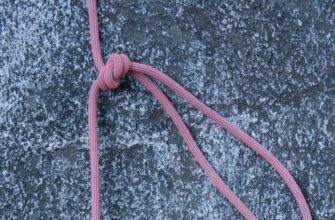What is lead climbing? Lead climbing is a very popular and exciting form of rock climbing that promises thrill, adventure, and memorable experiences. Everything you need to know to get started with this amazing sport will be explained in detail in this article.

- Lead climbing: overview
- Learning to lead climb
- Challenges
- Communication
- Risks
- Endurance
- Managing rope drag
- Belaying in lead climbing
- Lead climbing vs top roping
- Additional lead climbing tips
- FAQ
- What is the lead climbing process?
- What is lead climbing vs sport climbing?
- What is lead climbing in a gym?
- What is lead certified climbing?
- What is a lead test climbing?
- Conclusion
Lead climbing: overview
Lead climbing is an amazing form of rock climbing where the climber uses a rope attached to pre-positioned protection points on the wall to ascend a route from the bottom to the top. Unlike a top-rope climb, where the rope is anchored above as the climber ascends and they are protected from above, lead climbing adds a touch of adventure and risk.
As they ascend, the climber must place their protection, or gear, on the rock face and clip the rope to it for safety.
Climbers must place their protection as they ascend, this is one of the features that distinguishes a lead climb.
Climbers carry a rack of specialized equipment such as quickdraws, cams, nuts, and slings to protect themselves from falls. As they progress up sport climbing routes, climbers select appropriate placements and attach the rope to the protection points on the rock face.
This self-reliance on gear placement is different from when top roping, where the protection is pre-placed by someone else. It requires an extensive understanding of many forms of protection and the ability to assess the rock for suitable placements.

Learning to lead climb
When it comes to rock climbing, safety gear is essential, purchasing a belay device, climbing shoes, a helmet, and other essential equipment is very important for a safe climbing experience.
Belay devices help climbers and belayers manage the rope and belay safely, particularly when there is too much slack in the rope or when there is a rope stretch.
Lead climbing ropes are made to absorb the energy of a ground fall, these ropes are usually dynamic. To climb safely, you must understand the different kinds of protection available, such as quickdraws, nuts, cams, and slings.
The ability to read a route is a skill that can significantly impact your success as a lead climber. It’s important to plan your moves, recognize holds, and comprehend the terrain.
Efficiently and securely clipping the rope into your protection points on the rock face is fundamental for safety. Mastering various clipping techniques ensures you fall safely in case something unexpected happens like if an issue occurs with the belay device.
Strength, endurance, and flexibility training are necessary to get your body ready for the physical demands of lead climbing. Progress requires specialized training plans and exercises designed for climbers.
Completing a lead climb brings an amazing sense of accomplishment. According to many experienced climbers, it instills self-confidence and a lasting memory of the thrill of overcoming physical and mental challenges.
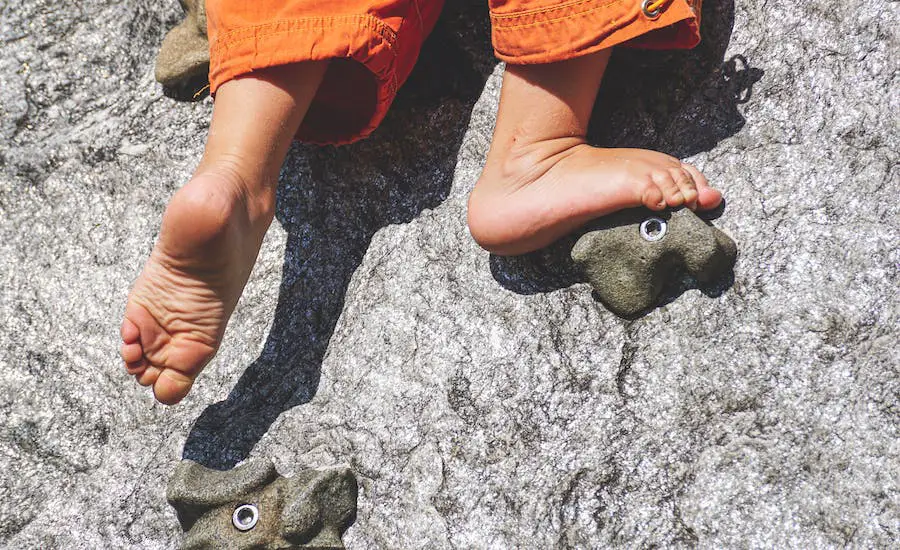
Challenges
There are numerous challenges that a lead climber may face, these challenges are explained below.
Communication
Vocal commands that are clear and concise are the first step in effective communication in lead climbing, the lead climber issues commands to instruct the belayer on how to manage the rope.
Climbers frequently communicate verbally about specific holds or information about the route. This can include tips on where to set up your equipment, alerts for dangerous terrain, or recommendations for rest stops.
Climbers can also support their verbal commands with visual cues like hand signals, gestures, or even facial expressions.
In situations where verbal communication is challenging due to distance, ambient noise, or language barriers, climbers and belayers rely on tugs or pulls on the rope as a form of signaling.
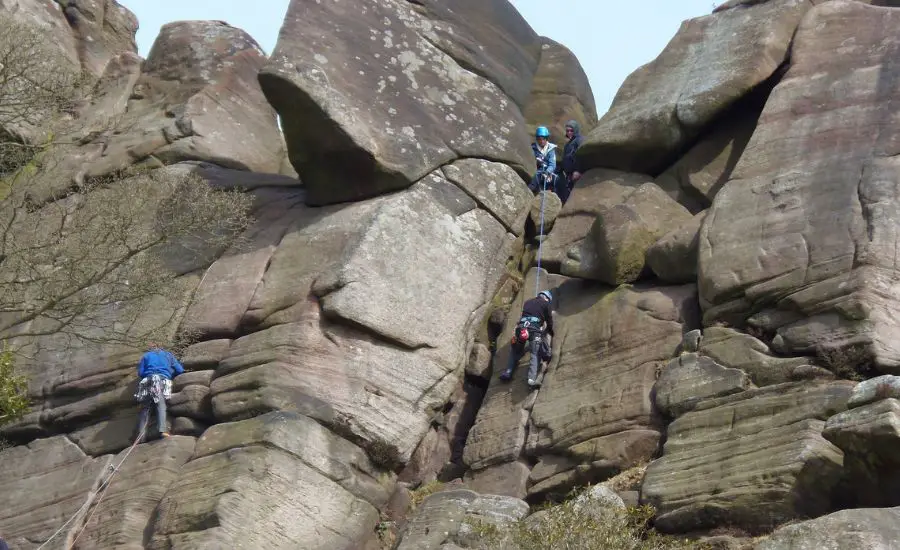
Risks
Falling is the most obvious and immediate risk during a lead climb. Lead climbers run the risk of suffering significant falls while ascending. Unlike top-rope climbing, where the climber is securely supported by fixed anchors. These fixed anchors are used to ensure the safety of the lead climber. These falls can range from minor slips to long and potentially dangerous descents.
The placement of gear is an essential part of risk in lead climbing. Climbers depend on their ability to choose and fasten safety equipment into artificial holds or the rock, such as quickdraws, nuts, cams, and slings. Incorrect placements may result in gear failure, which raises the risk of a fall.
The choice of route selection also plays a significant role in determining risk, climbers must evaluate a route’s difficulty, exposure, and protection options, taking into account their abilities and the conditions of the climb. Choosing a route that exceeds one’s skill level can lead to increased risk.
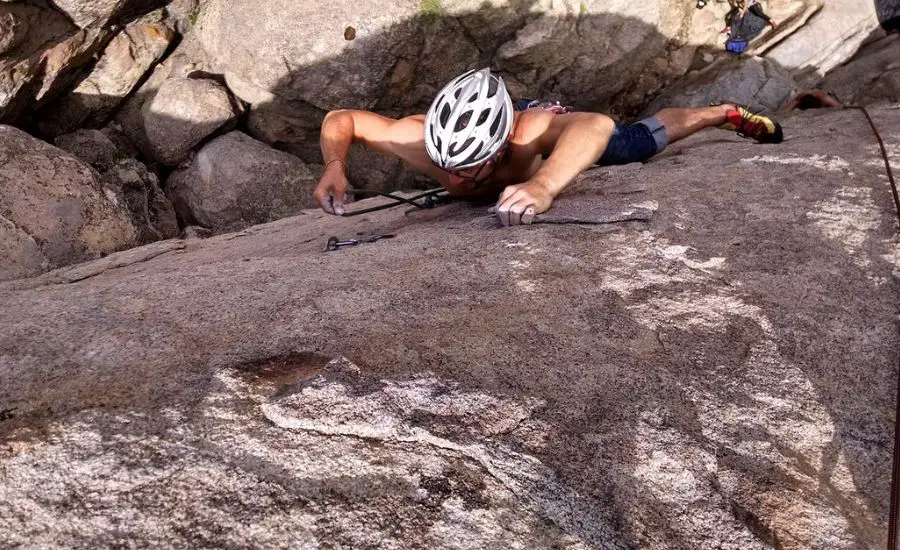
Endurance
Physical stamina is a primary factor that determines endurance in lead climbing. Climbers frequently face steep and overhanging ascents, which require them to maintain their muscular effort for extended periods. Longer routes require this type of endurance because the strain of constant tension, difficult holds, and intense effort can wear out muscles.
Climbers frequently struggle mentally to get through challenging sequences, foresee the need to place protection, and control their fear of falling.
Throughout the climb, mental endurance entails focusing, controlling anxiety, and making the best decisions.
Climbers often encounter routes that demand sustained effort, where they must maintain a high level of tension and exertion for an extended period. These routes are particularly demanding on both physical and mental endurance, as climbers must find ways to conserve energy and focus their efforts efficiently.
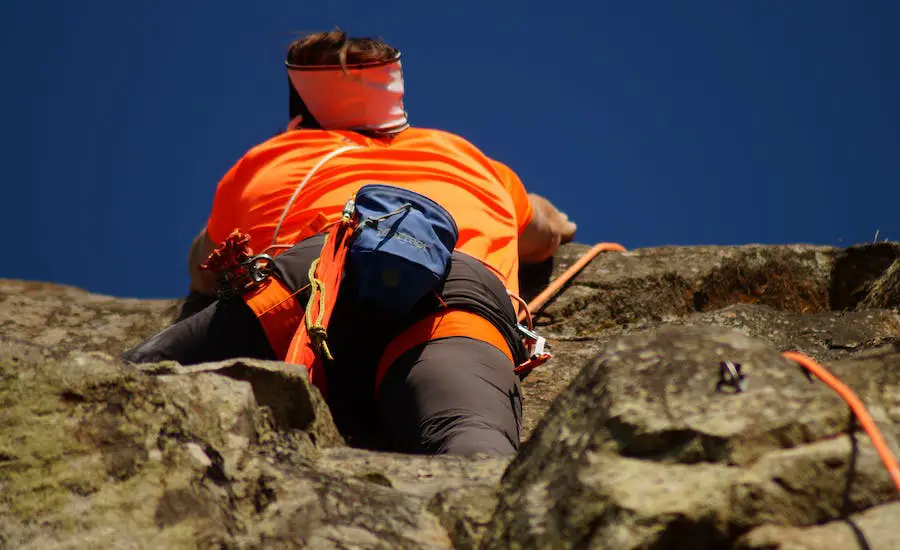
Managing rope drag
Rope drag occurs when the climbing rope experiences friction as it runs through protection points, quickdraws, and other gear during an ascent. This friction can impede the smooth movement of the lead rope and create resistance from the end of the rope that the climber must overcome when pulling in slack or ascending.
The lead climber must exert more physical effort when there are rope drags or too much slack. Overcoming drag requires more energy, which can cause premature fatigue and impair performance and endurance.
Efficiency is a key element in lead climbing, where every move should be purposeful and precise. Rope drags disrupts this efficiency, causing the climber to waste time and effort on managing the rope.
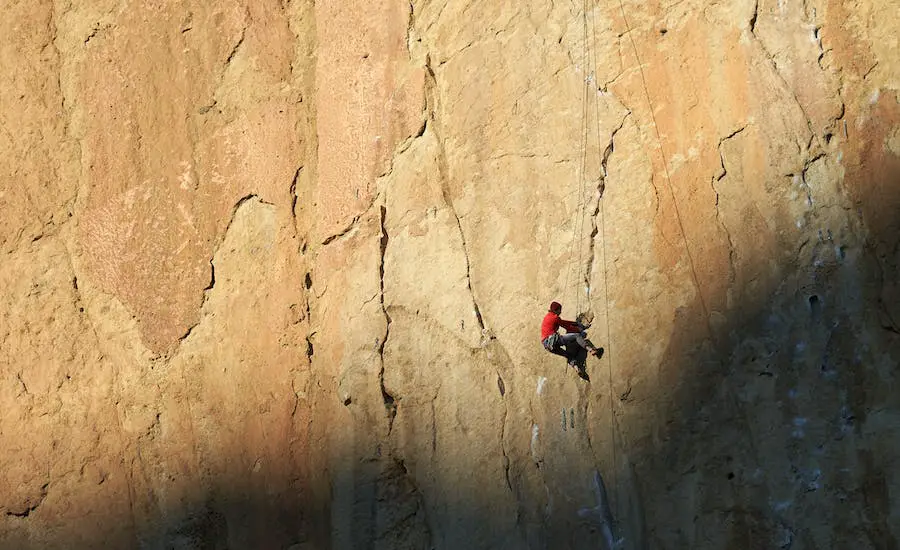
Belaying in lead climbing
In lead climbing, the lead belayer plays a pivotal role in ensuring the climber’s safety, they are in charge of controlling the rope in case the climber falls, providing slack when needed, and preventing falls. When lead belaying, the belayer’s alertness and reflexes can prevent serious mishaps and guarantee a fun and safe climbing experience.
The climber and the belayer must communicate effectively. The belayer is responsible for listening to, understanding, and accurately responding to the climber’s commands. Communication must be timely and clear for an ascent to be successful.
While lead belaying, as the belayer is anchored to the ground or in a secure position, it serves as the climber’s anchor point. This anchoring keeps the rope taut, providing stability and a safety net for the climber.
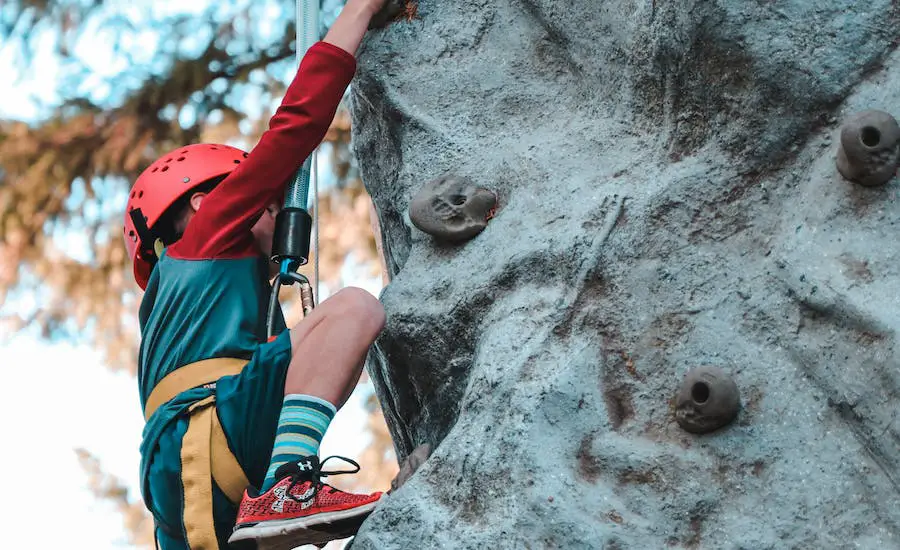
Lead climbing vs top roping
Top roping is often considered the best sport to enter the climbing world, it’s a great option for starters and those seeking a safe and less exhausting climbing experience.
In top-roping, the climber is attached to a rope that is already anchored at the top of the climbing route. Because the rope is always above the climber and ready to catch it in the event of a fall, this setup offers a high level of safety.
Higher levels of physical and mental toughness are required for lead climbing.
Climbers have to make rapid choices about where to put their gear, route reading, and handling fear and exposure.
Lead climbing requires more experience than other climbing sports like trad climbing and top-rope climbing. Both trad climbing and top-rope climbing are excellent for beginners as they offer safety and ease of learning.
Lead climbing is the perfect choice for individuals seeking more adventure, and a mental and physical challenge, it opens the door to exploration and pushing your limits in both outdoor and indoor climbing.
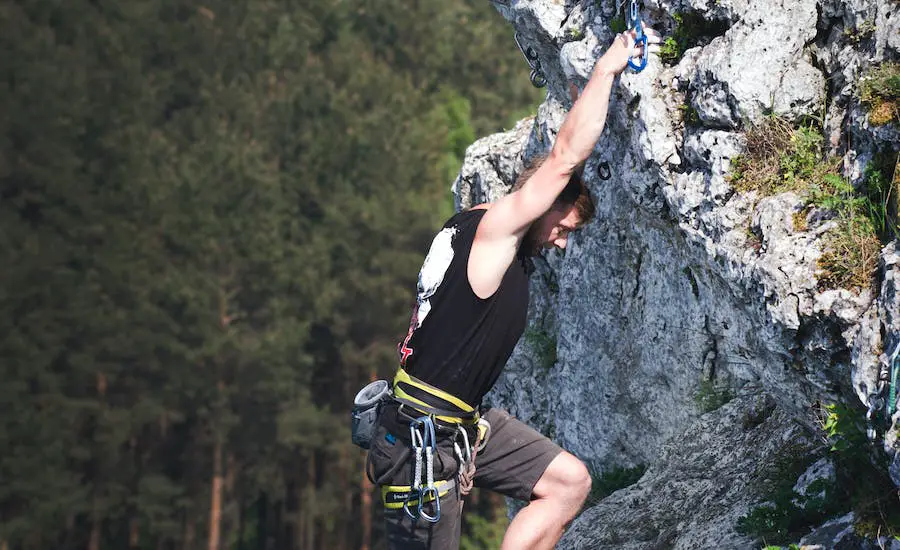
Additional lead climbing tips
- Relaxing. Tension in your muscles can lead to premature fatigue, focus on staying relaxed as much as possible, and only engage your muscles when necessary.
- Mock lead. A mock lead is a type of climbing exercise where a climber practices without actually ascending a route. Since lead climbing requires practice, a mock lead can a lead climber help you maintain balance and make climbing easier for both the climber and the belayer.
- Hydrating. Climbing can be physically demanding, so make sure to stay hydrated and maintain proper nutrition to fuel your body for sustained effort.
- Gear and safety. Safety is essential for both the climber and the belayer, wearing a recommended helmet, climbing shoes, and other safety gear is important.
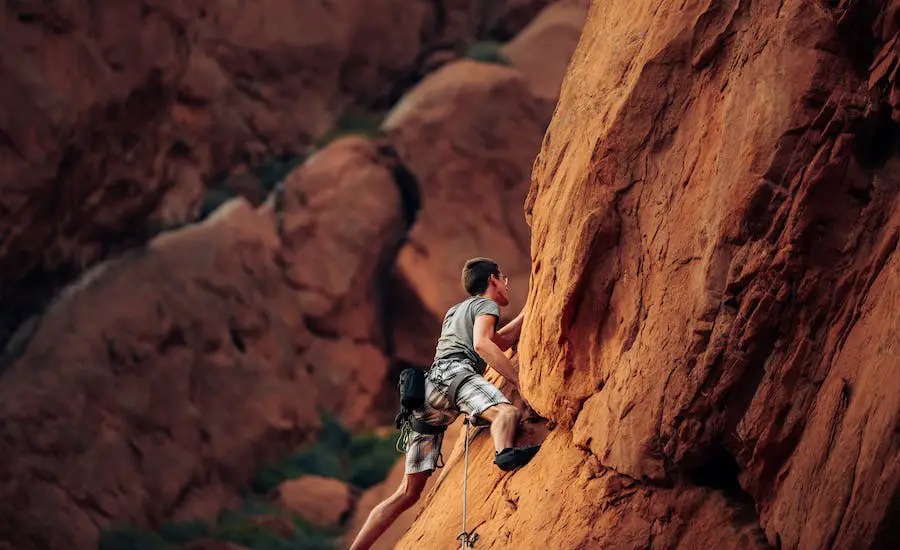
FAQ
What is the lead climbing process?
The process involves ascending the wall while the rope is fastened to the wall, a partner stays down to feed the rope and ensure safety.
What is lead climbing vs sport climbing?
Sport variety of climbing involves climbing on a route with pre-installed protective bolts while lead climbing involves using your protective gear while climbing.
What is lead climbing in a gym?
Practicing lead climbing in a climbing gym involves climbing a route without any connection with a top anchor.
What is lead certified climbing?
Lead-certified climbing involves practicing lead climbing while being officially recognized as a professional and competent lead climber.
What is a lead test climbing?
Lead test climbing is an evaluation process that is conducted to analyze the skills, experience, and proficiency of a lead climber.
Conclusion
Navigating the challenges of this sport might be challenging, but it’s undoubtedly worth it. By following the necessary safety precautions and using this article as a guide you can excel greatly in the sport and have a timeless lead climbing experience.










